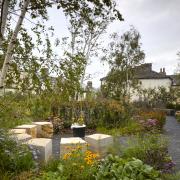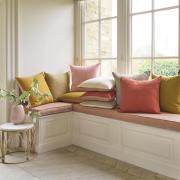With spring in full swing, for many of us thoughts turn to refreshing and revamping our homes.
The work from home space has been an integral part of home life over the past few years but it is all too often an overlooked opportunity to boost wellbeing.
We all know the importance of an ergonomic chair and having a computer screen at the right height but there are some remarkably simple biophilic design techniques which can further support wellbeing while we work.
Whether you work from home full time, follow hybrid work patterns or indeed are back in the office full time there are some simple ways to make your space work harder to support you.
Using the principles of biophilic design, any workspace can be improved. The Human Spaces Report 2015 revealed that workspaces with added elements of, or connection to, nature can increase wellbeing and uplift feelings of creativity by 15 per cent and improve productivity by six per cent.
These are significant numbers, and with a few tweaks to the places we inhabit for our working day you can help maximise your space.

DESK DIRECTION
Working in natural light with easy access to fresh air are key ingredients in creating a comfortable working environment. An open window can bring fresh air in and let toxins out while you can also hear the birds, feel the breeze and observe the passing of the seasons. Being able to control air flow and temperature to suit your personal comfort needs is the ideal scenario.
A desk placed under (or near) a window is optimal for soaking in as much natural light as possible, especially important during winter months. Having the opportunity to rest your eyes and look out of a window for a moment really helps maintain focus through your working day.
It is not always possible, of course, to position your desk under or close to a window, especially in an open plan office. In a home office consider using a mirror to reflect a view which will help you feel connected to the outside world.
If there is no window or view, position artwork around you that features nature=based imagery such as a woodland scene photograph, a landscape painting or botanical print. If this artwork is somewhere special or significant to you, it is all the better for enhancing your working experience by connecting you to a favourite place or space to which you feel an emotional attachment. This image can be the calm you need to rest your eye upon during a busy working day.
Having nature inspired art (when you cannot see the real thing) helps to soothe the brain and offers momentary respite from flickering screens.

HARD-WORKING PLANTS
Sharing any space with plants is proven to be beneficial for your health, so your workspace should not be forgotten.
Plants give you a direct connection to nature, making your home office area feel more alive and dynamic. Plants also work extremely hard for humans, with their leafy benefits including:
• Functioning as natural air purifiers, improving indoor air quality by removing toxins and pollutants
• Helping boost productivity
• Lowering stress levels and anxiety which helps regulate our nervous system
• Boosting creativity and clear thinking.
Plants also make a wonderful acoustic screen. If you work from home in an open office, screening your work area with plan/multi-functional living space or in an plants is an effective way to create some privacy and a sense of separation.
To help reduce acoustic reverberation place large leaved plants in the corners of the room as this will help soften sounds bouncing off sharp corners; this is especially effective in open plan spaces.

STRESS LESS WITH STORAGE
When it comes to an efficient home office, space storage is a top priority especially when your workspace is integrated into a part of your home that is a multi-functional living space too.
Work clutter is a distraction and can make a stressful environment. Making storage a priority when designing a home work space helps keep the mind clear for focused tasks.
There are much more stylish freestanding storage units available now that don’t look obviously office-like, such as these tonal green metal lockers in the stylish home of British furniture designer Jo Coe (@lifeatlivingroom on Instagram). If you work from home full time and want to really maximise every inch of space, consider the built-in option.
Estate agents are now saying that a well-appointed home office space is a real selling point for buyers. For inspiration look no further than the home of interiors stylist and colour consultant Sarah Doyle (@retwiggdstylist).
Sarah has recently refreshed her creative home work space. Not only do her built-in cupboards maximise every inch of space but they also show just how beautiful and colourful a work space can be.
Don’t be afraid to use colour too to personalise your home office. With rich tones of pink, plants galore and a place for everything, Sarah has the ultimate balance of style versus practical storage solutions.

NATURAL MATERIALS
If you have the choice, always opt for a solid wood desk. When you spend prolonged periods at a desk, being able to touch a natural material helps keep you connected to nature. In studies, real wood has been found to relax the brain, leaving more brain power free to work on other functions.
Research has also shown that having real wood in our homes helps to reduce and regulate blood pressure.
Real wood adds warmth and texture that will make your working environment much more comfortable. Wood is natural, tactile and soothing – nobody ever waxed lyrical about the properties of MDF.
Choosing solid wood does not have to be an expensive choice either with so many great opportunities to recycle and reuse. I picked up a small pine kitchen table to use as my home office desk for £35 from Facebook Marketplace.
I found a large pine kitchen table to use as a studio desk from Mitchells Auctions for the bargain price of £60. With a little DIY (I stripped the top and painted the legs), I now have my table of choice without a hefty price tag while also reusing an old piece of furniture.
If your workspace has hardwood or tiled floors add a natural fibre rug, or choose wool for fitted carpets. Natural fibre is the first choice for a warming solution to connect your workspace to nature while minimising any toxins from synthetic fibres.
TIME OUT FROM TECH
The blue light from devices can play havoc with our natural circadian rhythms. If you spend a lot of your day on a computer (especially on highly focused tasks) it is important to take a break and create time for respite from your screen.
During the darker months (or when working late and it is dark outside), change the settings on your device to night-time mode, which uses an amber screen tone during dark hours. It helps to protect your eyes and reduce the negative effects on your natural body clock.
Blue light tricks the brain into believing it is still daylight which stops the production of melatonin, which in turn affects sleep patterns.

TAKE A BREAK
Creating a comfortable refuge that is away from your desk can really help break up your working day. This reduces task fatigue and helps you feel more invigorated when you do return to your desk.
Modern office space designed with the wellbeing of staff in mind will have a staff break out space to achieve just this.
If your home office is a dedicated room, consider creating a comfortable seating space just like digital interiors creator Laura Cave (@lauracavehome) has done in her home. She has added a comfortable chair at one end of her home office to create a cosy reading space. Having this softer space makes a great option for different workday tasks like taking a break from your screen to read a document or to make notes, enjoy a coffee break or a lunchtime spot, all of which help you break up the time you sit at a desk.
By having the space in which to relax with some creature comforts while working helps avoid too much task fatigue. If your workspace is in a guest bedroom, consider giving the bed more of a ‘day bed/sofa’ appearance with extra cushions and a blanket.

FRAGRANCE
Fragrance is an often-overlooked element in a workspace design. It is a crucial part of my life and a tool I use to help my mental wellbeing.
The right fragrance for the task at hand helps me feel balanced – it helps me stay focused yet also relaxes me.
I use pure and natural essential oil aromatherapy candles to help boost my mood while working. Be sure to use only natural fragrances and candles made with 100 per cent natural ingredients to avoid bringing any unwanted nasty chemicals in (fernandfell.com).
Fragrance is of course highly personal, but my recommendations are:
• For during the day: select energising citrusy fragrances that help you feel uplifted and energised.
• For highly focused tasks: use a fragrance containing rosemary which is known to aid focus and promote recall and memory; it is thought to have been used for these purposes by Greek scholars who wore rosemary crowns.
• In the evening: opt for warmer florals, woody and spicy fragrances to help create the balance between focus and relaxation.
I would avoid lavender scents during the evening in a workspace as these may be too relaxing if you need to stay focused
Fragrance may be a design element best suited to the home office rather than shared workspaces unless all colleagues can agree upon a mutually appreciated scent.
Connecting all our senses to nature, including smell, is a much-overlooked design technique and one which really boosts overall wellbeing.
Find out more about biophilic design at astoryofhome.com or on Instagram @a_story_of_home





























